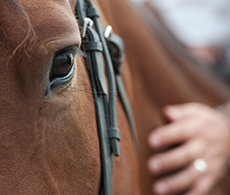
How to help a spooky horse
Spooking is a horse’s natural reaction to something frightening – but what makes horses spook in the first place? Discover the potential reasons behind this behaviour, plus how to bombproof a spooky horse.
Has your horse ever spooked for no apparent reason? Usually, this means they have seen, heard, or smelt something that scares them – and spooking is an instinctive response. That’s because when horses sense something potentially threatening, physiological changes occur that prepare them for immediate action. This is known as the fight-or-flight response.
Why do horses spook?
A horse’s first reaction to danger tends to be flight. This means that when they’re startled by something, they tend to run a safe distance from the perceived threat. This distance depends on each horse’s experience combined with the severity of the situation, but could be just a few strides or as much as a kilometre.
If flight isn’t possible, other behavioural reactions can also occur. Some horses might freeze – a response that often results in them being labelled stubborn or lazy. If a horse feels cornered or unable to escape, they might choose to confront their fear and fight – but this is unusual except in extreme circumstances.
Spooking behaviour varies between horses, and their level of reaction is usually a result of both heredity and prior experiences.
What might be causing spooky behaviour?
Many different things can cause spooking – from a noisy dog running onto a bridleway, to thunder and lightning, fireworks, or changes to familiar objects.
When startled by something from the front or side, horses may spook or shy by moving quickly away from the object in question. This puts more distance between them and the object, but also gives them the opportunity to look at the object from a different perspective. Because horses have almost 350-degree vision, they can also spook at things behind them.
Different horses will often react to the same object in different ways. You might know which objects your horse is most likely to spook at, in which case the confidence-building tips below will be useful. But if your horse’s usual behaviour changes and they become spookier than normal, it’s important to rule out pain as a potential cause.
When being ridden, pain could make your horse move suddenly or react unpredictably. Common sources of pain your vet will want to rule out include:
- Lameness
- Gastric ulcers
- Dental problems
- Orthopaedic issues
- Visual issues including cataracts and age-related retinopathies
How to calm a spooked horse
If your horse spooks at something while out riding, stay calm. It’s best to slow down, stop and let your horse look towards whatever has scared them. By relaxing and taking the pressure off, you’re giving your horse time to assess the object they’re interested in.
Some horses will then approach a scary object and try to sniff it. Horses have a strong sense of smell, which can help them understand what the object is, and help them relax when they realise it’s not a threat.
When schooling, if your horse spooks in a particular spot each time, slow down and don’t make a big deal of it. Usually, horses will stop spooking once they realise there’s nothing to be scared of. But bear in mind that when you change rein, they’ll see the object totally differently out of their other eye, so be prepared for them to spook again.
When your horse spooks, it’s best to try and sit as still and secure as possible. Kicking or pulling your horse can mean they also associate this pain or discomfort with their fear response and will be more likely to shy or spook in the future.
Rider confidence also makes a difference – because horses can pick up on when we’re feeling tense or anxious. Try to stay relaxed and don’t react to their spooking. This can help to improve your horse’s confidence, too.
How to build confidence in a spooky horse
The best way to build your horse’s confidence is to gradually introduce them to new experiences and novel objects. That’s because horses naturally learn that a new stimulus is nothing to worry about through a process called habituation – simply getting used to it over time.
This is a gradual process, and as long as your horse isn’t frightened at any stage, they’ll learn that a new stimulus is safe the more times they experience it.
Here are some tips to make this experience as stress-free as possible:
- Introduce your horse to new objects, one at a time. If possible, place these in their field and let them approach when they’re ready. You can also do this in an arena on a loose lead rope and reward them for each forward step they take.
- Brush up on your equine body language skills so you can recognise early signs of anxiety or stress. If you notice these, give your horse the time and space they need to look at the new object.
- Don’t rush. If your horse stops when approaching something new, allow them to assess it on a loose rein. Give them the freedom to raise and lower their head and turn to the side, which helps them get a better look at whatever they’re scared of.
- If your horse spooks while you’re out hacking, try to walk around the scary object in an arc. This reduces the pressure on your horse, so they’ll hopefully walk past with more confidence.
- Environmental enrichment can help reduce behavioural problems including excessive fear, so consider offering your horse more mental stimulation and objects to investigate in their field or when free-schooling.
- Hacking out with another, more relaxed and experienced horse can help calm your horse and give them an extra boost of confidence.
Have you got a spooky horse? Share your experiences and tips on Petplan Equine’s Facebook page.



